What is Eo Gio?

Eo Gió is a coastal viewpoint and boardwalk on the Phuong Mai Peninsula in Nhơn Lý, about 19–25 kilometers from Quy Nhon city. It’s a dramatic natural cove shaped like a saddle, where wind funnels through rocky cliffs and turquoise water crashes against the shore.
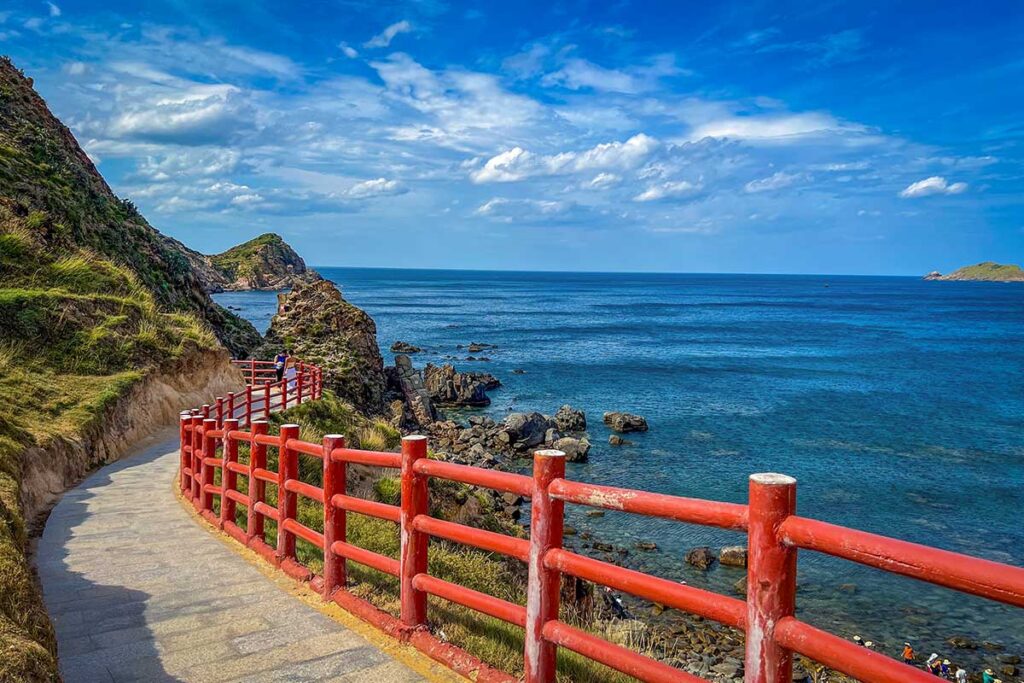
A stone promenade with white-and-red railings makes it easy to walk along the hillside and take in the scenery. The site itself is a small, ticketed attraction—the walk is short, the main draw is the view, and most travelers combine it with other nearby stops.
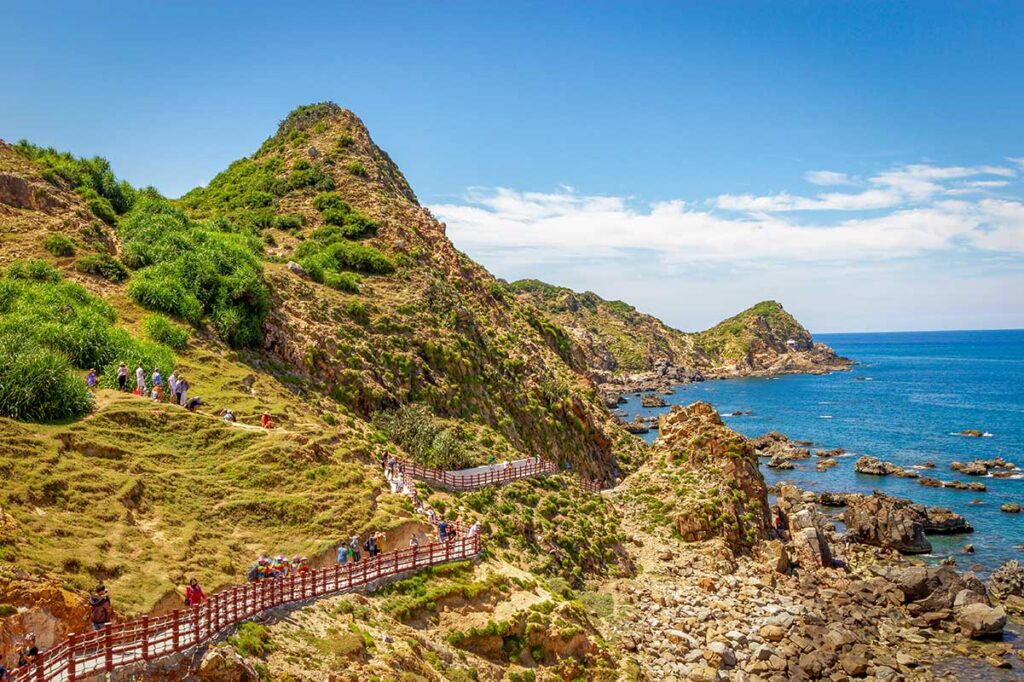
Expect it to be crowded with domestic tourists snapping selfies, especially during peak hours, and the heat and sun can feel intense. Still, the striking cliffs and breezy atmosphere make it a quick but memorable stop when exploring Quy Nhon’s coastline.
Location & Getting there
Where is Eo Gio?
Eo Gio is located in Nhơn Lý commune on the Phuong Mai Peninsula, about 19–25 km northeast of Quy Nhon. To reach the peninsula you’ll cross Thi Nai Bridge, then follow Vo Nguyen Giap Road before connecting with National Road 19B toward Nhơn Lý. The trip takes around 30 minutes from Quy Nhon city center.
Taxi or Grab
Taking a taxi or Grab is the simplest option to get there. The ride from Quy Nhon costs only a few US dollars, but the issue is usually the return trip—Grab cars are rarely available around Eo Gió. A practical solution is to ask your driver to wait, since most visitors only spend 30–60 minutes here.
Car with driver (half-day loop idea)
If you want to see more than just Eo Gió, arranging a car with driver is more efficient. This way you can combine Eo Gió with Ky Co Beach, the Phuong Mai Sand Dunes, and even a quick stop in Nhơn Lý fishing village. You pay a fixed price for the itinerary, the driver waits for you at each stop, and you don’t have to worry about finding transport in between.
Motorbike (self-drive)
Renting a motorbike in Quy Nhon is popular and the roads around the peninsula are fairly quiet, with only occasional tour vans. It’s a scenic ride, but keep in mind that an international driving permit is legally required in Vietnam if you want to drive yourself.
Local bus
There is a local bus from Quy Nhon (near Co.opmart) to Nhơn Lý, but it’s not a practical option for most foreign visitors. The buses are basic, drivers rarely speak English, and connections can be confusing. For independent travelers, a motorbike or car remains the more convenient choice.
Highlights of visiting Eo Gió
1. The coastal boardwalk & viewpoints

The main feature of Eo Gió is its stone-paved boardwalk that curves along the cliffs with red-and-white railings. The path is very short—often less than 15 minutes end to end—but it gives sweeping views of the bay and the turquoise sea below.

This is where most of the classic photos are taken. The path is easy enough for all ages, though you’ll want good shoes if you plan to step off onto the rocks.
2. Rocky beach & strata

A set of stairs leads down from the boardwalk to a rocky beach lined with boulders and rounded pebbles. The exposed rock layers make for interesting photos, but the stones can be slippery when wet. If you head further out onto the rocks, move carefully and expect to get your feet wet—this is more about taking a look than spending time on the shore.
3. Wind & sea color

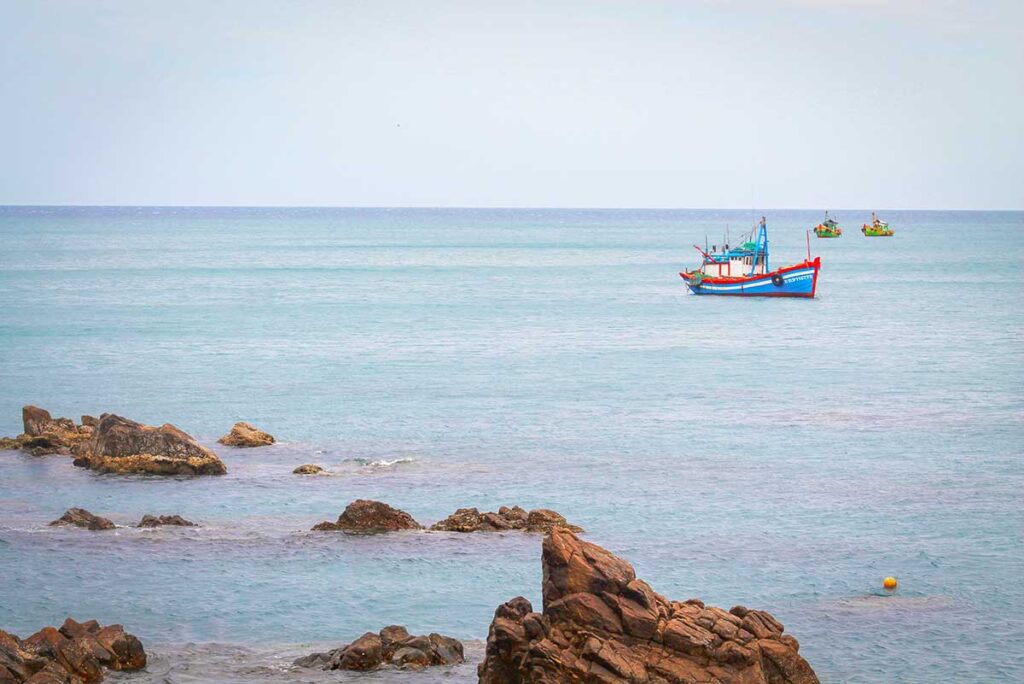
The name Eo Gió translates to “Wind Strait,” and the reason is obvious once you’re there. Strong gusts blow through the curved saddle between the cliffs, giving the area its refreshing (and sometimes fierce) breeze. The sea color shifts from deep blue to turquoise depending on the light, especially striking in the early morning or late afternoon when the sun is softer.
4. Snorkeling add-on (when seas are calm)
Some visitors try snorkeling around the rocky edges or join a local boat to nearby spots. The water can be clear, with the chance to see small fish and coral. Still, this is not a full beach day destination—the main appeal is the view, and snorkeling is more of a small extra if conditions are right.
5. Ngoc Hòa Monastery (double-faced Guanyin)
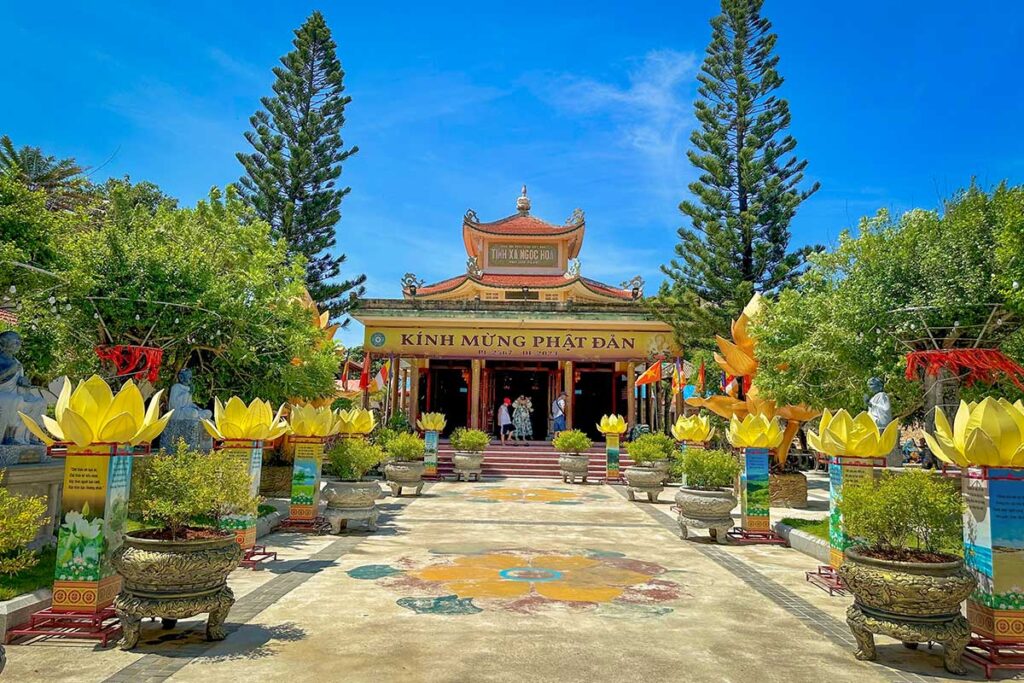

Just next to Eo Gió stands the Ngọc Hòa Monastery, home to Vietnam’s tallest double-faced Guanyin (Quan Âm) statue—about 30 meters including its base. One side faces the sea, the other faces the land, symbolizing protection in both directions. It’s worth a short look, and since it’s right beside the boardwalk entrance you don’t need extra travel time.
6. Nhon Lý fishing village snapshots

The fishing village around Eo Gió adds some local color. You’ll see round basket boats pulled up on the beach and simple seafood stalls near the road. If you arrive very early, the small morning market is lively with fishermen bringing in their catch. Even outside those hours, wandering the alleys gives a glimpse of coastal life that feels different from Quy Nhon city.
Practical visiting information & tips
Entrance fee & hours
The entrance fee is around 25,000 VND per person. Some online sources mention open access at all hours, but in practice most visitors enter through a ticketed gate with daytime opening (roughly 7:00–19:00). Bring small cash, as card payments are not accepted.

How much time you need
Eo Gió is not a full outing—20 to 60 minutes is plenty for a walk along the boardwalk, a few photos, and perhaps a look down by the rocks. It’s best combined with other sights on the peninsula.
When to go (season & time of day)
The dry season from February to September offers the best conditions, with calm seas and clearer skies. To avoid crowds and harsh sun, go early in the morning. Sunsets can also be striking, but expect more visitors at that time.
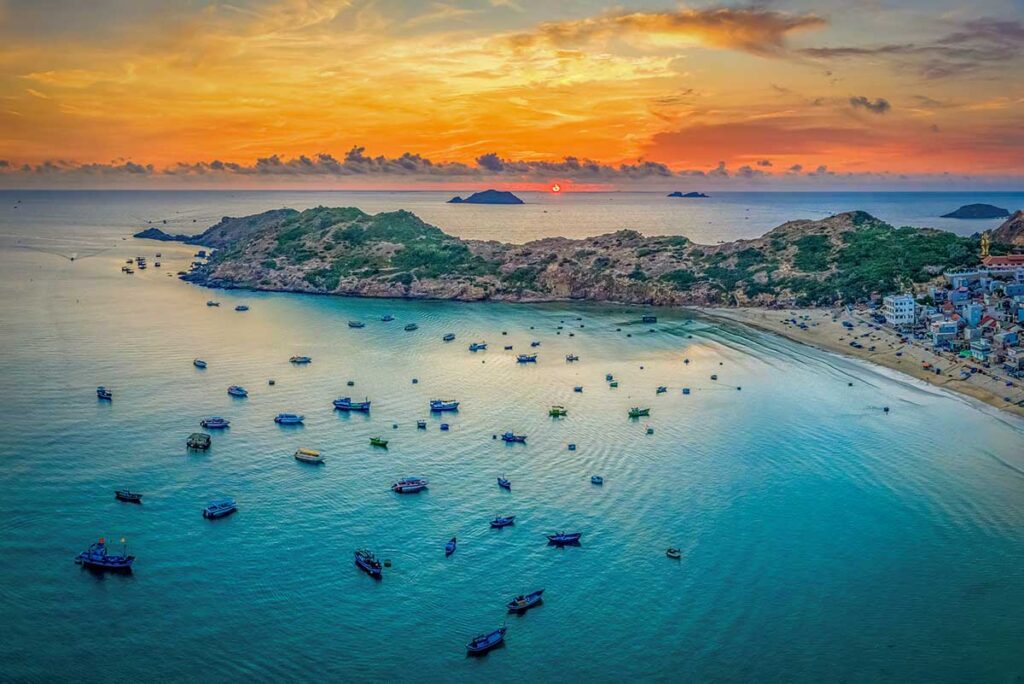
Sun, wind & heat management
There is very little shade, so bring a hat, sunscreen, and water. The strong coastal winds are refreshing but can knock hats and phones out of your hands—keep a good grip.
Footwear & safety
The paved path is easy, but if you go down to the boulders, wear sturdy shoes and move carefully. Rocks can be slippery, and the terrain is not ideal for anyone with knee or mobility problems.
Facilities
Facilities are minimal. Toilets are sometimes available but not always well maintained, so plan ahead and carry tissues. Don’t expect cafés or convenience stores at the site itself—refreshments are easier to find in the fishing village.
Cleanliness expectations
On some days the coves look pristine, on others wind and waves wash up plastic and other debris. This varies with tides and weather. Manage expectations and don’t be surprised if you encounter litter along the shore.
Photography pointers
The classic shot is from the boardwalk with its curved red-and-white railings against the turquoise sea. Morning light is softer, while evenings bring warmer tones. Look for foregrounds with rocks, or zoom in for goats grazing on the cliffs.
Not a beach destination
It’s worth stressing that Eo Gió is not a place to swim or relax on the sand—it’s mainly a scenic stop for views and photos.

If you want to actually swim or spend time by the water, nearby Nhơn Lý Beach is the closest option, a simple local beach where you can sit and cool off. For something more striking, Ky Co Beach just a few kilometers away is considered one of the most beautiful in the region, though it comes with higher entrance fees (by Vietnamese standards) and can get quite crowded on weekends and holidays.
Nearby sights to combine
Eo Gió itself is a quick stop, so it makes sense to combine it with other attractions on the Phuong Mai Peninsula. The peninsula has a mix of beaches, dunes, and fishing villages, and putting them together makes the trip more worthwhile than going only for the boardwalk.
Ky Co Beach (≈6–10 km)
Often paired with Eo Gió, Ky Co Beach is known for its fine sand, turquoise water, and dramatic cliffs. You can get there by road or sometimes by boat tours departing from Nhơn Lý. It’s the most popular beach in the area, which means it can get crowded, and there is a paid entrance fee that’s relatively high by local standards. Still, if you want swimming and a proper beach setting, this is the best choice nearby.
Phuong Mai Sand Dunes (≈6–10 km)
The Phuong Mai Sand Dunes rise behind Nhơn Lý and offer wide coastal views. Some dunes are modest at 20–30 meters, while others reach up to around 100 meters. It’s a good place for sand-boarding or short climbs for the panorama, especially around sunrise or sunset. Don’t expect Sahara-sized dunes, but they do make a fun contrast with the sea.
Nhon Hai & island snorkeling
On the end of the peninsula lies Nhơn Hải, another fishing village that also serves as a starting point for island-hopping and snorkeling trips. Tours often include stops at nearby small islands with coral and fish, but conditions depend heavily on the season and sea state. If you’re after more activity than just walking and sightseeing, it’s worth looking into.
Is Eo Gió worth visiting?
Eo Gió is worth a stop if you’re already exploring the Quy Nhon area, but it’s not a major attraction on its own. The cliffs and boardwalk are scenic, the wind and sea air are refreshing, and the photos turn out well. At the same time, the walk is short, facilities are limited, and crowds can make it feel more like a photo stop than a deep experience.
The best way to enjoy it is to treat it as part of a loop with nearby Ky Co Beach and the Phuong Mai Sand Dunes, or a seafood meal in Nhơn Lý village. Go early in the day to avoid heat and busier hours, and you’ll find Eo Gió a pleasant, breezy highlight—just not the kind of place you linger for half a day.


